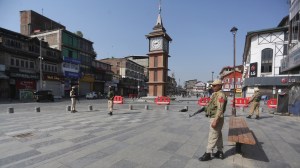UPSC Essentials | Daily subject-wise quiz : Environment and Geography MCQs on archipelago of Svalbard, Makran subduction zone and more (Week 105)
Are you preparing for UPSC CSE Prelims 2025? Check your progress and revise your topics through this quiz on Environment and Geography.
 Check your progress and revise your topics through this quiz on Environment and Geography. Find a question on the archipelago of Svalbard in today's quiz. (Photo: Special Arrangement)
Check your progress and revise your topics through this quiz on Environment and Geography. Find a question on the archipelago of Svalbard in today's quiz. (Photo: Special Arrangement)UPSC Essentials brings to you its initiative of subject-wise quizzes. These quizzes are designed to help you revise some of the most important topics from the static part of the syllabus. Attempt today’s subject quiz on Environment and Geography to check your progress.
🚨 Click Here to read the UPSC Essentials magazine for March 2025. Share your views and suggestions in the comment box or at manas.srivastava@indianexpress.com🚨
QUESTION 1
With reference to the Modernisation of Command Area Development and Water Management (M-CADWM), consider the following statements:
1. It is a sub-scheme of the Pradhan Mantri Krishi Sinchayee Yojana(PMKSY).
2. It will make robust backend infrastructure for micro-irrigation by farmers from established source to the Farm gate upto 1 Ha with underground pressurized piped irrigation.
3. Internet of Things technology will be used for water accounting and management.
How many of the statements given above are correct?
(a) Only one
(b) Only two
(c) All three
(d) None
Explanation
— The Centre has approved the Modernisation of Command Area Development and Water Management (M-CADWM) as a sub-scheme of the Pradhan Mantri Krishi Sinchayee Yojana (PMKSY) for the year 2025-2026, with an initial total outlay of Rs 1,600 crore. Hence, statement 1 is correct.
— The program intends to modernise the irrigation water delivery network by supplying irrigation water from existing canals or other sources in a specific cluster. It would build a strong backend infrastructure for micro-irrigation by farmers from an established source to the farm gate, covering up to 1 ha with underground pressurised piped irrigation. Hence, statement 2 is correct.
— Water accounting and management will be carried out using Supervisory Control and Data Acquisition (SCADA) and Internet of Things technology, according to the release. This will improve farm-level water use efficiency (WUE), boost agricultural production and productivity, and thereby raise farmers’ income. Hence, statement 3 is correct.
— Irrigation Management Transfer to the Water User Society will ensure the projects’ long-term viability. For five years, Water User Societies will be offered handholding support in connecting them with existing Economic Entities such as FPO (Farmer Producer Organisations) or PACS (Primary Agricultural Cooperative Societies). The youth will also be drawn to farming, particularly the contemporary technology of irrigation.
Therefore, option (c) is the correct answer.
QUESTION 2
With reference to the heatwave, consider the following statements:
1. A heatwave is declared when the “maximum temperature of a station reaches at least 30 degree C or more for plains and at least 20 degree C or more for hilly regions.
2. A severe heatwave is declared when the departure is more than 6.4 degree C.
Which of the statements given above is/are correct?
(a) 1 only
(b) 2 only
(c) Both 1 and 2
(d) Neither 1 nor 2
Explanation
— Many sections of India remained hot, with soaring temperatures showing little signs of abating. The India Meteorological Department (IMD) predicts that isolated areas in Odisha, Jharkhand, and Gangetic West Bengal would experience hot conditions.
— A heatwave is defined as a period of unusually high temperatures across a certain location. Thus, the threshold for declaring a heatwave is determined by the average temperatures in that place at that time of year. So, what is deemed a heatwave in Kerala will not be referred to as such in Odisha.
— According to the IMD, a heatwave occurs when the “maximum temperature of a station reaches at least 40 degree C or more for plains and at least 30 degree C or more for hilly regions.” Hence, statement 1 is not correct.
— A heatwave is announced when the departure from normal temperature is between 4.5 and 6.4 degrees Celsius, while a severe heatwave is called when the departure exceeds 6.4 degrees Celsius. Hence, statement 2 is correct.
— In coastal locations, a heatwave can be proclaimed if the highest temperature deviates by 4.5 degrees Celsius or more from normal and the actual maximum temperature exceeds 37 degrees Celsius.
Therefore, option (b) is the correct answer.
QUESTION 3
The Makran subduction zone lies in:
(a) Pacific Ocean
(b) Mediterranean Sea
(c) Atlantic Ocean
(d) Indian Ocean
Explanation
— Natural terrain and the existence of several inland water bodies make coastal villages in Kerala particularly vulnerable to tsunamis, according to officials from the Hyderabad-based Indian National Centre for Ocean Information Services (INCOIS).
— Tsunamis are’magnanimous series of sea waves’ caused by undersea earthquakes, underwater landslides, and submarine volcanic eruptions, among other things. On December 26, 2004, the Indian Ocean tsunami devastated Tamil Nadu and Kerala, causing major damage and killing hundreds of people along the coastline.
— According to INCOIS scientists, all Indian coastal Union Territories and states are vulnerable to tsunamis caused by two subduction zones: the Andaman-Nicobar-Sumatra Island Arc and the Makran Subduction Zone.
— The Makran Subduction Zone (MSZ), located in the northern Indian Ocean, is a tectonic plate boundary where the Arabian Plate subducts beneath the Eurasian Plate, creating a seismically complex zone prone to earthquakes and tsunamis.
Therefore, option (d) is the correct answer.
QUESTION 4
The archipelago of Svalbard was in the news. It is located in:
(a) Russia
(b) Denmark
(c) Iceland
(d) Norway
Explanation
— Rising temperatures are causing rapid and largely irreversible changes in the world’s mountain ranges, according to a new UNESCO assessment. In numerous areas, higher elevations appear to be warming faster than lower elevations; glaciers are melting at a quicker rate; permafrost is thawing faster; snow cover has decreased; and precipitation patterns have become more unpredictable.
— The ‘The United Nations World Water Development Report 2025 – Mountains and glaciers: Water towers’ was released on March 21, the first World Day for Glaciers.
— Glaciers are melting at a quicker rate than ever before, with the previous three years seeing the worst glacier mass loss ever recorded. According to the World Glacier Monitoring Service (WGMS), scientists assess the status of a glacier by tracking how much snow falls and melts each year.
— Last year, glaciers in Scandinavia, the Norwegian archipelago of Svalbard, and North Asia had the greatest yearly loss of total mass on record.
— Warmer temperatures aren’t the sole factor driving glacier melting. More frequent and intense wildfires and dust storms are causing increased deposition of black carbon and other particle matter on glacier surfaces and perennial snowpacks.
Therefore, option (d) is the correct answer.
QUESTION 5
This state has a total coastline of about 560 km, and it has 46.13 square km of estuaries and backwaters in addition to two freshwater lakes. With large portions of its land under water, the challenge posed in the wake of a tsunami event is huge. The state has narrow land-stretches that lie between the backwater and the sea.
The above mentioned statements refer to:
(a) Tamil Nadu
(b) Odisha
(c) Kerala
(d) Karnataka
Explanation
— With a total coastline of approximately 560 km, Kerala features 46.13 square kilometres of estuaries and backwaters, as well as two freshwater lakes. Except for three, the state’s 41 perennial rivers flow into the Lakshadweep Sea. With major areas of its territory under water, the challenge in the aftermath of a tsunami will be enormous.
— Kerala features many backwaters, which are tiny sections of land that connect the backwater to the sea. When tsunami waves attack, coastal villages and the immediate inland regions would be more vulnerable than villages in Odisha, which already have ‘tsunami ready’ people. While some lessons can be shared between Odisha and Kerala, the local authority in Kerala would need to use different techniques while planning and carrying out evacuations.
Therefore, option (c) is the correct answer.
Previous Daily Subject-Wise-Quiz
Daily Subject-wise quiz — History, Culture, and Social Issues (Week 105)
Daily subject-wise quiz — Polity and Governance (Week 105)
Daily subject-wise quiz — Science and Technology (Week 105)
Daily subject-wise quiz — Economy (Week 105)
Daily subject-wise quiz — Environment and Geography (Week 104)
Daily subject-wise quiz – International Relations (Week 104)
Subscribe to our UPSC newsletter and stay updated with the news cues from the past week.
Stay updated with the latest UPSC articles by joining our Telegram channel – IndianExpress UPSC Hub, and follow us on Instagram and X.
Must Read
Buzzing Now
Apr 24: Latest News
- 01
- 02
- 03
- 04
- 05


























